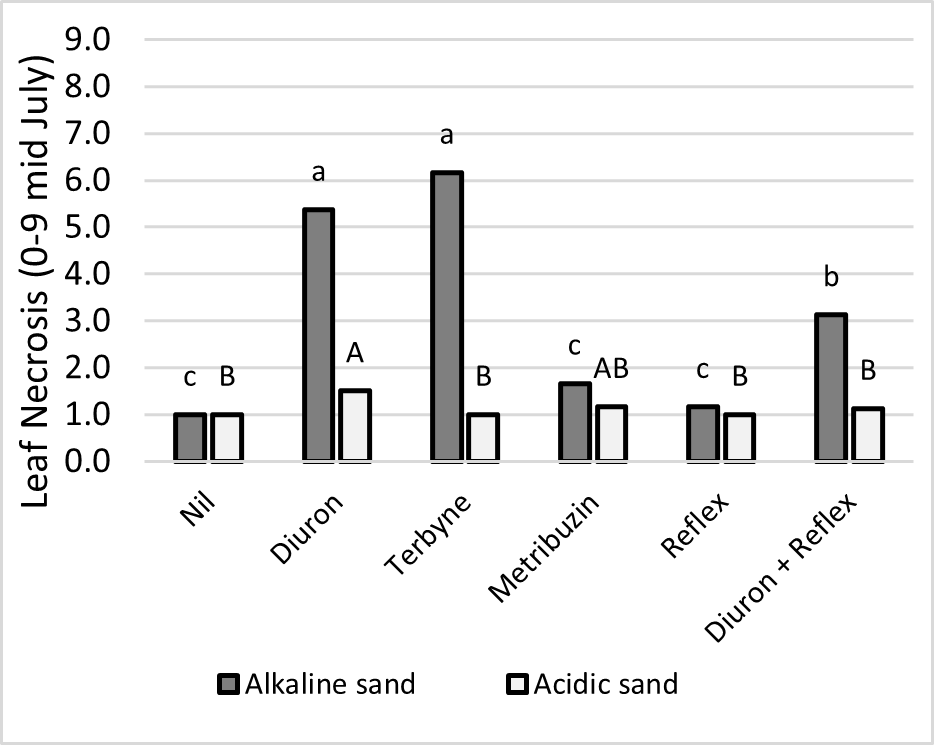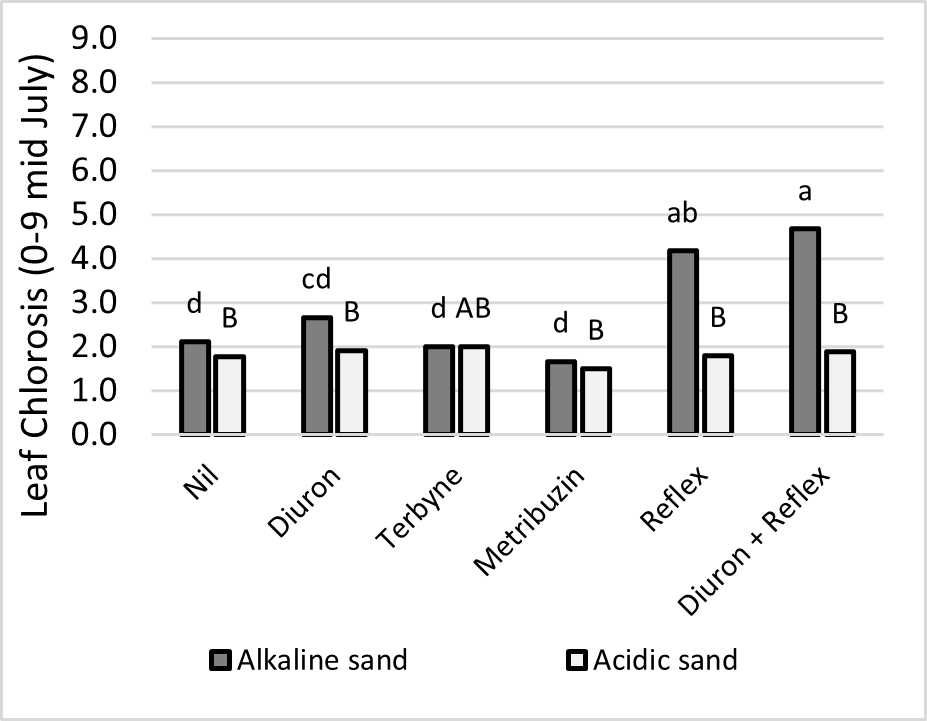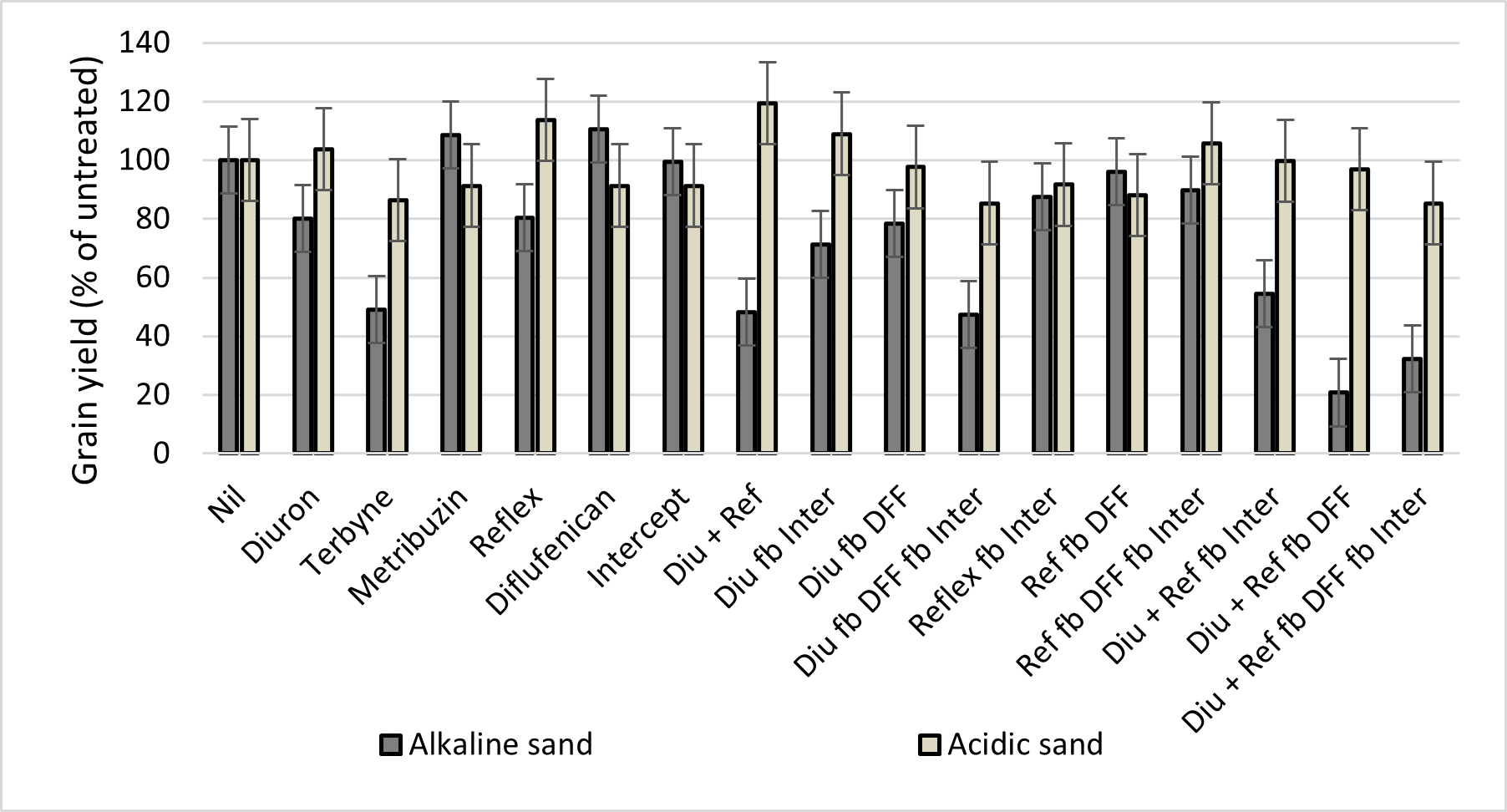Lentil variety update and the existing herbicide options in pulses
Lentil variety update and the existing herbicide options in pulses
Take home messages
- New lentil varieties are available and should be considered based on performance in independent evaluation, and the characteristics required in individual cropping systems.
- The Yorke Peninsula is considered a potentially higher disease risk region for Ascochyta blight, Botrytis grey mould and Sclerotinia, so disease management strategies should be based on disease resistance ratings where available. Fungicides with different modes of action should be used in rotation and applied ahead of a rain fronts following label directions.
- Lentil crop safety varied significantly between acidic and alkaline sands in 2021 trials using Reflex®, diuron, metribuzin and terbuthylazine herbicides. Alkaline sand sites incurred more herbicide damage than acidic sand sites.
- Crop damage on alkaline sands was cumulative where Reflex was applied in combination with a group 5 herbicides, such as diuron.
Background
Lentil crop plantings remain strong on the Yorke Peninsula(YP), with the crop being of high economic importance to the cropping rotation in this region. As such, there is a need to understand strategies to improve crop yield. In such dryland farming systems, improving crop yields can be achieved through improved breeding and agronomy. When considering agronomic crop management, several strategies can be considered to achieve improved yields including variety selection, sowing date, density, both pre-crop and in-crop pest management, and harvest timing. This paper will focus on lentil variety selection, and disease and weed management strategies.
Results and discussion
Lentil variety update
The four latest releases in lentil have been GIA Lightning, PBA KelpieXT, GIA Leader, and PBA HighlandXT. These are all herbicide tolerant red lentil varieties with similar IMI herbicide tolerance characteristics to other XT varieties. Further lentil releases are anticipated over the coming seasons with independent data expected to be available in 2023.
Lentil variety seed type, agronomic traits, and disease resistance ratings can be found in Table 1.
When selecting suitable varieties, it is important to consider the agronomic characteristics and how these match the local climate, soil type, paddock history, disease risk profile, and agronomic management. This should be done in addition to the yield potential information available from independent research trials (Table 1). Note that there are no resistance ratings in lentil for Sclerotinia, but there is a greater risk this season due to the wetter than average winter and above average rainfall forecast for spring.
Disease management in lentil
The disease management strategies are based on the variety resistance rating (Table 1 and Table 2), the disease, and the disease risk depending on seasonal conditions and intensity of production in that region. On the YP crops generally achieve canopy closure, and climatic conditions are often conducive to disease, so the region is considered to have a higher disease risk for AB and BGM as well as Sclerotinia. An example fungicide regime is shown in Figure 1.
Ascochyta blight (AB)
The current recommendation for control of AB in lentil in the medium-high rainfall zone starts with applying a thiram-based seed dressing at sowing. For resistant (R) and moderately resistant (MR) varieties, crops should be monitored, and fungicide applied ahead of a rain front from mid-September if AB is present, with a second spray at podding if rain is forecast, to prevent pod infection and seed staining. For moderately susceptible (MS) varieties, an additional earlier spray timed with canopy closure may be required if AB is present and numerous rain fronts are forecast. For the Yorke Peninsula, pathotype 2 of AB is widespread in this region and early disease on volunteer lentil is common and can provide a source of inoculum for crops. It would be expected that many of the lentil crops on the Yorke Peninsula receive multiple fungicide applications within the season. Thus, it is important to rotate fungicide groups to avoid fungal resistance developing and to apply fungicides at the correct timing for harvest withholding periods (Table 3).
Botrytis grey mould (BGM)
The recommendation for BGM control in the medium-high rainfall zone is for all varieties, regardless of resistance rating, to be sprayed prior to canopy closure. Additional sprays are then recommended ahead of major rainfall events in high-risk situations every 2–3 weeks for MS and susceptible (S) varieties. For MR and R varieties, sprays are recommended ahead of rain in extreme disease risk situations. BGM is a problem in wet seasons, particularly with high spring rainfall or prolonged high humidity and mild to warm temperatures.
Table 1: Compiled variety information from public release NVT 2020 and 2021 Southern Region trials.
Variety | Ascochyta blight | Botrytis grey mould | Averaged Yield Ranking - Southern Region (2020 and 2021) | ||||||||
|---|---|---|---|---|---|---|---|---|---|---|---|
Pathotype 1 (Nipper-virulent) | Pathotype 2 (Hurricane-virulent) | Higher Yield Potential Environments (>2t/ha) | Low Yield Potential Environments (<2t/ha) | Vigour | Flowering time | Maturity time | Lodging resistance | Pod drop | Shattering | ||
PBA KelpieXT | MRMS | MRMS | MRMS(p) | 7 | 7 | Moderate – Good | Early – Mid | Early – Mid | MRMS | MR | R |
PBA Jumbo2 | R | RMR(p) | RMR(p) | 3 | 4 | Moderate – Good | Mid | Mid | MRMS | MR | R |
GIA Thunder | R(p) | MRMS(p) | MRMS(p) | 1 | 1 | Moderate | Mid | Mid | – | – | – |
PBA HighlandXT | MR | MR | MS | 6 | 5 | Moderate – Good | Early | Early – Mid | MR | MR | MR |
PBA Hurricane XT | RMR | MRMS | MS | 5 | 5 | Moderate | Mid | Mid | MR | MR | R |
GIA Lightning | R(p) | MRMS(p) | MS(p) | 2 | 2 | Moderate | Mid – Late | Mid | |||
GIA Leader | MR(p) | MR(p) | MR(p) | 4 | 3 | Moderate | Mid – Late | Mid-late | MR* | MR* | – |
PBA Hallmark XT | RMR | MRMS | MR(p) | 8 | 5 | Moderate – Good | Mid | Mid | MR | MR | R |
Key: R = resistant, MR = moderately resistant, MS = moderately susceptible, S = susceptible, VS = very susceptible, (p) = Provisional rating and subject to change when additional data becomes available.
Table 2: NVT disease ratings and what they mean. From NVT Online.
Rating Category | Definition | |
|---|---|---|
R | Resistant | No symptoms visible. No fungicides are required. |
RMR | Resistant to Moderately Resistant | The disease may be visible but will not cause significant plant damage or loss. However, under high disease pressure or highly favourable environments conditions fungicide applications may be required e.g. to prevent seed staining. |
MR | Moderately Resistant | The disease may be visible but will not cause significant plant damage or loss. However, under high disease pressure or highly favourable environments conditions fungicide applications may be required e.g. to prevent seed staining. |
MRMS | Moderately Resistant to Moderately Susceptible | The disease symptoms are moderate and may cause some yield and/or seed quality losses in conducive conditions. Fungicide applications, if applicable, may be required to prevent yield loss and seed staining. |
MS | Moderately Susceptible | Disease symptoms are moderate to severe and will cause significant yield and seed quality loss in the absence of fungicides in conducive seasons, but not complete crop loss. |
S | Susceptible | The disease is severe and will cause significant yield and seed quality loss, including complete crop loss in the absence of fungicides, in conducive conditions. |
VS | Very Susceptible | Growing this variety in areas where a disease is likely to be present is very high risk. Significant yield and seed quality losses, including complete crop loss can be expected without control and the increase in inoculum may create problems for other growers. |
Table 3: Compiled fungicide information for registered use on lentil crops.
Active (Product) | Group | Sprays per crop | Notes |
|---|---|---|---|
Bixafen + Prothioconazole (for example, Aviator® XPro®) | 7 + 3 | 2 | DO NOT apply after early flowering; Minimum re-treatment interval of 28 days; Harvest withholding nil when used as directed; Do not graze or cut for stock feed for 5 weeks post application. |
Tebuconazole + Azoxystrobin (for example, Veritas Opti®) | 11 + 3 | 2 | ; Minimum re-treatment interval of 14 days; Harvest withholding 28 days; Do not graze or cut for stock feed for 4 weeks post application. |
Pydiflumetofen + fludioxonil (for example, Miravis® Star) | 7 + 12 | 2 | DO NOT apply after end of flowering; Minimum re-treatment interval of 14 days; Harvest withholding nil when used as directed; Do not graze or cut for stock feed for 6 weeks post application. |
Carbendazim | 1 | 2 | Harvest withholding period 28 days |
Procymidone | 2 | 2 | Harvest withholding period 21 days |
Mancozeb | M3 | Harvest withholding period 28 days | |
Captan | M4 | 2 | Minor Use Permit PER81406 expires 30.09.2023; Application 8-10 weeks after emergence; Minimum re-treatment interval of 7-14 days between consecutive applications; Harvest withholding period 14 days; Do not graze or cut for livestock feed for 14 days after final application |
Boscalid | 7 | 2 | Minor Use Permit PER82476 expires 31.05.2027. Initial application at beginning of flowering, second application 7-14 days later. DO NOT apply more than four (4) applications to same paddock per year. Harvest withholding period 21 days; Do not graze or cut for livestock feed for 21 days after final application |
Crop safety implications for herbicide products in lentil
Background
Reflex® (fomesafen 240g/L) herbicide has been recently registered for use in chickpea, narrow leaf lupin, lentil, field pea, faba bean and vetch. Of all the pulse species with a Reflex registration, lentil is the most sensitive, with a maximum rate of 1L/ha incorporated by sowing (IBS) only, whilst other legume species have a maximum rate of 1.25L/ha post-sowing and pre-emergence (PSPE) (except vetch, maximum 0.9L/ha PSPE) or 1.5L/ha IBS. Reflex is registered for control of broadleaf weeds, including wild radish, Indian hedge mustard, sow thistle, prickly lettuce and bifora when used at 0.75–1L/ha in lentils. A new mode of action registered in lentils will provide herbicide rotation options and will be particularly useful where herbicide resistance is developing.
Two sandy sites were selected for herbicide tolerance trials in 2021 with contrasting soil pH levels (Table 4). The Alford site was an alkaline sand with a 0–10cm soil pH (CaCl2) of 7.7, whereas the Bute site was an acidic sand with a 0–10cm soil pH (CaCl2) of 4.7.
Table 4: Herbicide products and application timing/method for the alkaline (Alford) and acidic sand (Bute) herbicide tolerance trials in 2021.
Herbicide product | Trial application | Trial rate (product) | Registered use pattern |
|---|---|---|---|
Diuron (900g/kg) | IBS | 830g/ha | 830–1100g/ha IBS |
Metribuzin (750g/kg) | IBS | 180g/ha | 180g/ha PSPE |
Terbyne® (terbuthylazine 750g/kg) | IBS | 750g/ha | 1.0–1.4kg/ha IBS |
Reflex (fomesafen 240g/L) | IBS | 1000mL/ha | 500–1000mL/ha IBS |
Intercept® (imazamox 33g/L + imazapyr 15g/L) | Post-emergent | 500mL/ha | 375–750mL/ha Post (Imi-tolerant varieties) |
Diflufenican (500g/L) | Post-emergent | 150mL/ha | 100–200mL/ha Post |
Crop safety


Figure 1. Early season leaf necrosis (left) and chlorosis (right), scored on 13 July at Alford (alkaline sand) and 20 July at Bute (acidic sand) (0 = no necrosis/chlorosis, 9 = plant death) of PBA Hurricane XT for the herbicide tolerance trials in 2021. Lower-case letters and upper-case letters denote significant differences for each site, P values = <0.001.
Early season herbicide damage scores indicate there were differences between the Alford and Bute sites (Figure 1). At the alkaline site (Alford), the group 5 herbicides diuron and Terbyne® caused significant herbicide damage with scores for necrosis of up to 6.2 out of 9 from the application of Terbyne. Reflex caused significant damage at this site but in the form of leaf chlorosis rather than necrosis. The combination of Group 5 and 14 herbicides at these sites did not lead to increased damage. In contrast, at the acidic site (Bute), there were only minor symptoms evident with the application of diuron and no other herbicide was significantly different from the control treatment.

Figure 2. Grain yield presented as percent of untreated for individual herbicide treatments at the acidic (Bute) and alkaline sand (Alford) herbicide tolerance sites in 2021. Nil = untreated control, Diu = diuron, Ref = Reflex, DFF = diflufenican, Inter = Intercept, fb = followed by. Bars represent LSD at P=0.05.
Grain yield was significantly reduced in response to the application of some herbicide treatments at the alkaline sand trial site (Figure 2), consistent with earlier herbicide damage scores. Diuron and Reflex treatments both reduced grain yields by 20% when applied alone, and Terbyne reduced yield by 51%. Where diuron and Reflex were applied in combination, yield loss increased to a 52% reduction in grain yield compared to the untreated control. This contrasts with the acidic sand site where no significant yield differences occurred in response to the application of any individual herbicide.
Post-emergent herbicides Intercept and diflufenican (DFF) alone did not cause yield loss at either site, which is consistent with results of Trengove et al. (2021) for similar soil types. Generally, DFF and Intercept were also safe to apply following applications of either diuron alone or Reflex alone. However, the use of diuron followed by DFF followed by Intercept caused significant yield loss from using both of these post-emergent products after an already damaging IBS application at the alkaline sand site. The most damaging combination of herbicides at the alkaline sand site was the combination of diuron plus Reflex® followed by DFF post-emergent. This treatment resulted in a grain yield reduction of 79%. The addition of Intercept to this treatment did not increase the level of damage further.
Opportunities in lentil agronomy
Pod loss in lentil
In 2021, two trials (Kulpura YP and Tooligie EP) focused on reducing pod loss in lentils were conducted. These trials tested several possible management treatments including higher seeding and fertiliser rates to increase canopy size, applications of the products EnviroShield® and Pod Ceal®, and harvest timing. While there were some treatment responses, the data suggest no benefits were realised from the treatments in these trials.
Conclusion
When planning a lentil seeding program, key considerations include variety selection, disease management, and herbicide management. When selecting suitable varieties, it is important to consider the agronomic characteristics and how these match the local climate, soil type, paddock history, disease risk profile, and agronomic management. For disease management, it is important to note that there are no resistance ratings in lentils for Sclerotinia, but there is a greater risk this season due to the wetter than average winter and above-average rainfall forecast for spring. For AB and BGM, note each variety’s current resistance ratings and monitor crops closely for symptoms. Ensure that fungicide sprays are timed ahead of rain fronts and be judicious with their use by rotating chemistries. When considering herbicide application, knowledge of soil type is important. Lentil crop safety varied significantly between acidic and alkaline sands in 2021 trials, with an alkaline sand site incurring more herbicide damage than an acidic sand site. Crop damage on alkaline sands was cumulative where Reflex was applied in combination with a group 5 herbicide, such as diuron. In a trial at Alford on alkaline sand, yield loss to either diuron or Reflex was 20%, increasing to 52% yield loss when applied in combination. Proper planning of lentil crop management can lead to improved production outcomes.
Acknowledgments
The research undertaken as part of this project is made possible by the significant contributions of growers through both trial cooperation and the support of the GRDC, the authors would like to thank them for their continued support.
References
Trengove S, Sherriff S, Bruce J (2021) Increasing reliability of lentil production on sandy soils. Proceedings GRDC Grains Research Update, Adelaide, February 2021, pp. 99–106.
2022 Pulse Australia Fungicide Guide
Contact details
Penny Roberts
SARDI
70 Farrell Flat Rd (PO Box 1078), Clare SA 5453
0436 678 982
Penny.Roberts@sa.gov.au
@PennyRo25927708
GRDC Project Code: UOA2105-013RTX,
